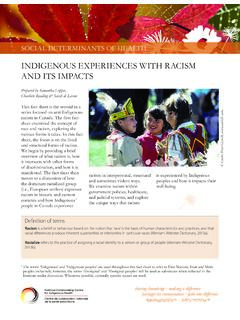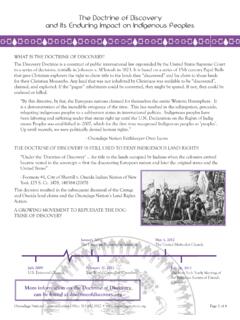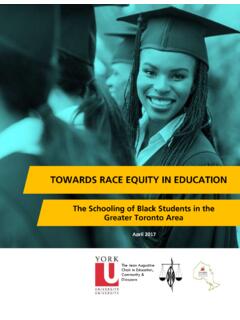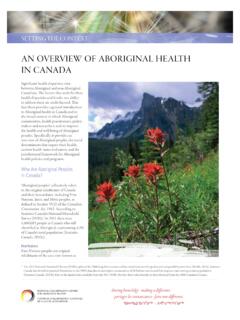Transcription of Indigenous Children and the Child Welfare System in …
1 Child , YOUTH AND FAMILY HEALTH sharing knowledge making a difference partager les connaissances faire une diff rence Indigenous Children AND THE Child Welfare System IN CANADA1 Indigenous in this fact sheet refers to First Nations, M tis and Inuit Peoples collectively. There will also be reference to First Nations Peoples as being status (or ordinarily resident on reserve or in the Yukon Territory) or non-status. 2 Jordan s Principle is a Child -first principle aimed at ensuring First Nations Children can access public services ordinarily available to other canadian Children without experiencing any service denials, delays or disruptions related to their First Nations status ( ). Credit: , ID 89883507On June 2, 2015, the Truth and Reconciliation Commission of Canada (TRC) released its final report on the history and impacts of the Indian residential schools (IRS) System in Canada. Over the course of its five year mandate, TRC Commissioners heard the voices and stories of over 6000 Indigenous 1 survivors.
2 They outlined their findings in a ten-volume legacy of IRS, using testimonies and research to outline impacts that continue to span through generations of First Nations, Inuit and M tis communities and to provide Calls to Action for people and organizations throughout Canada. The TRC reports comment extensively on Child Welfare , referencing it as a continuation of IRS in which the removal of Indigenous Children from their families and communities continues through a different System . With this continued crisis resulting in Children losing their languages, cultures and ties to their communities, the TRC cited changes to Child Welfare as its top Calls to Action. These Calls to Action include: reducing the overrepresentation of Indigenous Children in the care of Child Welfare ; publishing data on the exact numbers of Indigenous Children in Child Welfare and the reasons for apprehension and costs associated with these services; fully implementing Jordan s Principle; 2 ensuring that legislation allows for Indigenous communities to be in control of their own Child Welfare services; and developing culturally appropriate parenting programs (TRC, 2015a).
3 It is important to acknowledge and consider the legacy of IRS when looking at Indigenous Child Welfare in Canada in order to contextualize the roots of the Child Welfare crisis and ongoing removal of First Nations, Inuit and M tis Children from their homes and communities. 2 Credit: , ID 0169, Cree Kokum and Grandchild Kinship care is a long-standing tradition which involves relatives caring for other relatives. [..]. When Children required an alternative placement they were cared for within the extended family and all family members participated in caring for these Children (Carri re-Laboucane, 1997, ).Historical contextFirst Nations, Inuit and M tis peoples in Canada have traditional systems of culture, law and knowledge that ensured effective protection of Children for thousands of years. Despite diverse cultures, languages and traditions, Indigenous Peoples share a high value for Children , with a community-centered approach to caring for Children : kinship care is a long-standing tradition which involves relatives caring for other relatives.
4 [..]. When Children required an alternative placement they were cared for within the extended family and all family members participated in caring for these Children (Carri re-Laboucane, 1997, ).Relations in Canada between Indigenous Peoples and European settlers generally began on good terms; however, worldviews eventually collided as colonizers sought territorial control and adopted the view of Indigenous Peoples as savages. As a result, they imposed foreign, and often harmful, policies on Indigenous families which continue to affect families today (TRC, 2015a; TRC, 2015b). Such policies were the result of a deliberate attempt to civilize Indigenous peoples according to European standards, enacted in part by removing Indigenous Children from the influences of their families and communities by way of the Indian Residential Schools System (also including Indian Day Schools and industrial schools). There are many influential figures who have been involved in the removal of Children , including Duncan Campbell Scott, Acting Superintendent General of Indian Affairs.
5 His letter of August 22, 1895, addressed to the Deputy Minister of Justice, requested a warrant which would force the removal of Indigenous Children from their homes and into Residential Schools (Scott, 1895). Approximately 150,000 First Nations, Inuit and M tis Children went to Residential Schools in Canada until the closure of the last federally-run Indian Residential School in 1996 (TRC, 2015a). More than 40 years before the closure of the last IRS, a new form of Child apprehensions began to take root in the form of the Child Welfare System . Many apprehensions can be attributed to the addition of a new section ( ) in the Indian Act in 1951 which cleared the way for provincial and territorial laws to be applied to First Nations people living on reserve. Following this change, provincial and territorial Child Welfare authorities apprehended large numbers of Indigenous Children , beginning in the 1950s and intensifying in the 1960s and 1970s, 3 Indigenous Children and the Child Welfare System in Canada 3 This section is intended as an overview of Indigenous Child Welfare framework in Canada.
6 Sinha and Kozlowski (2013) provide further details in their article, The Structure of Aboriginal Child Welfare in Canada. The canadian Child Welfare Research Portal is also an excellent resource in terms of publications, resources and information pertaining to Child Welfare in Legal terminology for status First Nations Peoples, as set out in the Indian Act. Credit: , ID 92273774a period now commonly known as the 60s Scoop (Blackstock, 2011). Social workers placed some of these Children in Residential Schools, while many others were fostered or adopted into non- Indigenous homes. As federal policy began to favour integrating Indigenous Children into public schools, the IRS System started to lose its original purpose of educating and civilizing Indigenous Children . Instead, the schools remained open primarily as centres for Child Welfare placements (Milloy, 1999). The TRC (2015b) provided an example from Saskatchewan where, [t]he percentage of residential school Children who were there for Child - Welfare reasons only increased in the 1960s.
7 A 1966 study of nine Residential Schools in Saskatchewan concluded that of the students enrolled were there for what were termed Welfare reasons ( ). Due to federal and provincial/territorial funding disputes, apprehensions were usually the only Child Welfare service provided to Indigenous communities (Bennett, Blackstock, & de la Ronde, 2005). Indigenous communities began forming their own Child Welfare agencies in the late 1970s and early 1980s in order to provide culturally relevant Child Welfare services to Children , youth and families both on and off reserve. While these agencies have worked extremely hard to provide culturally relevant and holistic services, their reach is often limited by the ongoing control of government authorities over the legislation and funding of Child Welfare , including significantly less funding for Indigenous Children . Today s framework 3In Canada, Child Welfare services for Indigenous peoples are delivered in various ways depending on Indigenous group and location.
8 The next sections provide an overview of Child Welfare in Canada including funding and legislation arrangements, Child Welfare models, and types of and legislation First Nations Child Welfare services for Children ordinarily resident on reserve and in the Yukon Territory are funded federally, whereas all other Child Welfare agencies are funded provincially or territorially. It must be noted that a Supreme Court decision in 2016 (the Daniels decision) may change the course of funding for agencies serving M tis and non-status First Nations Peoples. The Supreme Court ruled that the federal government must classif[y] non-status Indians and M tis as Indians 4 under section 91(24) of the Constitution (Vowel, 2016, ). This would mean that like First Nations Peoples with status, non-status First Nation and M tis Peoples may be able to access services from existing First Nations agencies, or be eligible for Department of Indigenous and Northern Affairs Canada funding to create or support their own agencies.
9 The full implications of the Daniels decision have yet to be Credit: , ID 182744268 Sinha and Kozlowski (2013) also outline that the provincial and territorial government model can also apply on reserve with the federal government funding the services. According to John (2016), there are cases like this in British Columbia where the Ministry of Children and Family Development is responsible for service delivery on reserve when a First Nation has no delegated agency providing services to the Delegation is when provincial, territorial and/or federal governments grant specific powers to agencies to deliver Child Welfare services for a specified purpose but retain overall authority. Agencies fall under different categories of delegation. Many Indigenous Child and family service agencies provide delegated Child Welfare service delivery, either as full or partial delegation. Under the full delegation model, the agencies provide the full range of Child Welfare services (on or off reserve), including prevention, family support, protection, and guardianship.
10 In the partial delegation model, the provincial or territorial government provides protection and the agencies provide a limited range of services, most often prevention and guardianship (Sinha & Kozlowski, 2013). Integrated Some First Nations Child and family service agencies are expanding their service delivery to include members off reserve and these agencies are known as integrated agencies. The responsibility for Child Welfare lies with the First Nations agencies, with some direction from the provinces or territories (Sinha & Kozlowski, 2013; TRC, 2015c). Sinha and Kozlowski Provincial and territorial Child Welfare legislation applies to all Child and family service agencies in Canada, both on and off reserve. First Nations agencies, even though funded federally, are not exempted from provincial and territorial legislation since the federal government has never enacted [its own] Child Welfare legislation and prior to the opening of the First Nations Child & Family Service agencies, they went into agreements with the provinces to deliver Child Welfare services on reserve (First Nations Child and Family Caring Society et al.)






